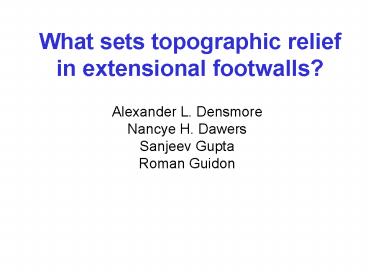What sets topographic relief in extensional footwalls - PowerPoint PPT Presentation
1 / 13
Title:
What sets topographic relief in extensional footwalls
Description:
Roman Guidon. Introduction. Amount of displacement and slip rates on fault surface increases away from fault ... L., Dawers, N. H., Gupta, S., Guidon, R., 2005. ... – PowerPoint PPT presentation
Number of Views:28
Avg rating:3.0/5.0
Title: What sets topographic relief in extensional footwalls
1
What sets topographic relief in extensional
footwalls?
- Alexander L. Densmore
- Nancye H. Dawers
- Sanjeev Gupta
- Roman Guidon
2
Introduction
- Amount of displacement and slip rates on fault
surface increases away from fault tips. - Footwall relief as a function of fault geometry
and spacing - Regulated by base level (theoretical lowest level
that erosion processes reach). - Limited by geomorphic processes rock mass
strength.
3
Study area
- Northeastern Basin and Range province.
- Fault lengths range between 140-150 km.
- Faults composed of linked segments.
- Reached their present extent 6 Ma.
(Densmore et al, 2005)
4
Google Earth image of Lemhi Fault
5
Estimates of displacement on studied faults
(Densmore et al, 2005)
6
Catchment, outlet spacing and range half-width
(Purdie and Brook, 2006)
7
Catchment relief as a function of slip
accumulation
- Catchment relief increases away from the
southeastern tips of the faults. - 20 km away from the southeastern fault tips,
catchment relief becomes relatively uniform.
(Densmore et al, 2005)
8
Catchment relief as a function of outlet spacing
and range half-width
- Catchment relief shows positive correlation
with outlet spacing and range half-width. - In other words, as outlet spacing and range
half-width increase, drainage basin relief on the
footwall increases.
9
Proposed catchment evolution model for studied
area
- First stage
- Outlet spacing and range half-width increase away
from the southeastern tips of the studied faults. - This stage continues until footwall relief
reaches 1000-1500 km (which occurs 15 km from
southeastern fault tip).
(Densmore et al, 2005)
10
- Second stage
- Catchment growth propagates towards range
half-width. - Once it reaches range half-width, catchments
reorganize and begin to compete with each other. - Result
- catchment elongation in the across-strike
direction. - Catchment widening in the along-strike direction.
- No change in catchment relief gtgt no change in
footwall relief.
(Densmore et al, 2005)
11
External controls on range width and relief
- Footwall width is controlled by
- Fault dip.
- Fault spacing.
12
- Footwall relief is controlled by
- Height of base level.
- Low in the hanging wall and high in the footwall
gtgt narrow range. - High in the hanging wall and low in the footwall
gtgt wide range.
13
References
- Densmore, A. L., Dawers, N. H., Gupta, S.,
Guidon, R., 2005. What sets topographic relief
in extensional footwalls? Geology 33, 453-456. - Purdie, H., Brook, M., 2006. Drainage spacing
regularity on a fault-block A case study from
the eastern Ruahine Range. New Zealand
Geographer 62, 97-104.































